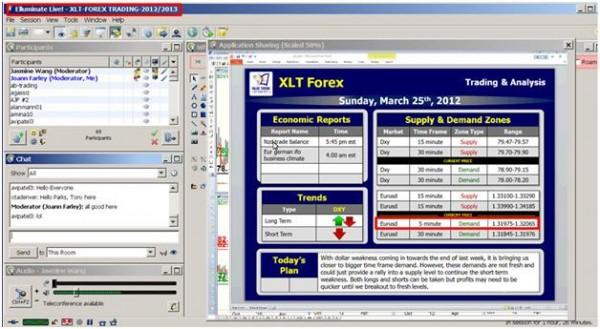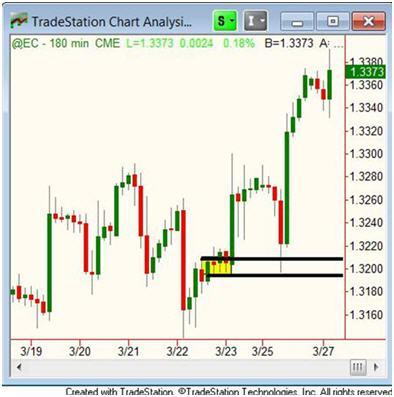
Singapore is one of the Forex trading hot spots on the planet. I live in Chicago in the USA but also spend time in Singapore. When I am with Singapore traders, I notice some of them are trying to make so many different strategies work in the Forex market yet none are achieving the success they are in search of. They don’t realize the key factor in trading is proper market timing: the ability to identify market turning points in advance, before they happen. It is also the ability to identify where market prices are going to go, before they go there. The main reason you would want to know how to time the market’s turning points in advance is to attain the lowest risk, highest reward, and highest probability entry into a position in the market. Think about it, by entering as close to the turn in price as possible, you enjoy three key factors:
1) Low Risk: Entering at or close to the turn in price means you are entering a position in the market very close to your protective stop. This allows for maximum position size while not risking more than you are willing to lose. The further you enter the market away from the turn in price, the more you will have to reduce position size to keep risk in line.
2) High Reward (profit margin): Similar to number one above, the closer your entry is to the turn in price, the greater your profit margin. The further you enter into the market from the turn in price, the more you are reducing your profit.
3) High Probability: Proper market timing means knowing where banks and institutions are buying and selling in a market. When you are buying where the major buy orders are in a market, that means you are buying from someone who is selling where the major buy orders are in the market and that is a very novice mistake. When you trade with a novice, the odds of success are stacked in your favor.
Forex bank trading strategy
So how do we time the market’s turning points in advance? It all begins and ends with understanding how to properly quantify real bank and institution supply and demand in any and all markets. Once you can do that, you are able to identify where supply and demand is most out of balance and this is where price turns. Once price changes direction, where will it move to? Price moves to and from the significant buy (demand) and sell (supply) orders in a market. So, again, once you know how to quantify and identify real supply and demand in a market, you can time the market’s turning points in advance, with a very high degree of accuracy.
To better understand how to do this, let’s take a look at a recent trading opportunity that was identified in our online graduate trading program, the Extended Learning Track (XLT) on March 25th. The XLT is a two hour live trading session with our students three to four times a week. During the session shown below, we identified an area of Demand in the EURO (highlighted in red) / 1.31975 – 1.32065. You can also see that Demand zone on the chart, the two lines creating a “buy zone”, allowing us to apply our simple rules for entering a position. This was an area of Bank/Institution Demand for a few reasons. First, notice the strong rally in price from the origin of that rally (the Demand level). Also, notice that price rallies a significant distance before beginning to decline back to the Demand level. These two factors tell us that Demand greatly exceeds Supply at this level. The fact that price rallies a significant distance from that level before returning back to the level clearly shows us what our initial profit margin (profit zone) is.
These are two of a few “Odds Enhancers” we teach in our graduate program. They help us quantify the bank and institution Supply and Demand in a market which is the key to knowing where the significant buy and sell orders are in a market. The plan with this trade was to buy if and when price declined back to that area of Demand. This trade was high probability but how do we know that? Well, being very confident that there is significant Demand at that level, this tells us that we will be buying from a seller who is selling at a price level where Demand exceeds Supply. Selling after a decline in price and at a price level where Demand exceeds Supply is the most novice move a trader can take. These are “retail” sellers selling where “banks and institutions” are buying. The retail sellers are selling with the odds stacked against them which means they are stacked in the buyer’s favor like our XLT members in this trade.

As you can see below, what happens next is price declines down to our predetermined Demand level where Banks and XLT members buy from sellers who are selling at extreme “wholesale” (Demand) prices. They are selling after that big decline in price and into that price level where Demand exceeds Supply.

Notice that price “declined” (down trend) to our demand level where we were willing buyers. Every trading book would say we are breaking the most important rules in trading by buying under those circumstances. Well, how many people do you know who read trading books that make a consistent low risk living year after year trading? I would be surprised if you knew one so be careful with what you read. The trading book version is conventional thinking which has you buying high and selling low so be careful. Don’t take my word for it however, read a trading book and ask yourself if how that book is teaching you to buy and sell in markets is the same as how you make money buying and selling anything in life. If there is any difference, good luck trying to profit from the information. Like anything in life, there is the book version way of learning to do something and the real world way. All we are doing at Online Trading Academy is simply sharing real world trading with you. We are not trying to reinvent the wheel. How you make money buying and selling anything in life is exactly how you make money buying and selling in markets. I learned reality based trading during my years on the trading floor of the Chicago Mercantile Exchange.
Shortly after reaching our demand level, offering XLT members a low risk buying opportunity in the XLT, price rallied and met the profit targets. This is market timing and while it does not guarantee that each trade will be a profitable trade, it does offer the lowest risk entry, highest reward with that entry, and highest probability of success. How high your winning percentage is with the strategy depends on your ability to identify key bank and institution supply and demand levels like we do at Online Trading Academy.
I sometimes hear people say “I don’t want to try to pick market tops and bottoms, I am only trying to catch the middle of the move.” They are trend followers and say that as if doing that is somehow easier. If price is already moving higher for example and you want to buy, where do you enter, where is your protective stop, what is your risk / reward and so on… I would argue that catching the middle of a move and making a consistent low risk living is harder than proper market timing. I am not suggesting the trend is not important. I just want our students to be in the market well before the trend is underway. The longer we wait to enter, the greater the risk and lower the reward. Another thing I hear people say so often is this: “I wish I knew where the Banks and Institutions were buying and selling.” Every time I hear this I say: “You can see where they are buying and selling, if you know what to look for on a price chart.” It all comes down to supply and demand, just like buying and selling anything else in life.
Note: All information on this page is subject to change. The use of this website constitutes acceptance of our user agreement. Please read our privacy policy and legal disclaimer. Opinions expressed at FXstreet.com are those of the individual authors and do not necessarily represent the opinion of FXstreet.com or its management. Risk Disclosure: Trading foreign exchange on margin carries a high level of risk, and may not be suitable for all investors. The high degree of leverage can work against you as well as for you. Before deciding to invest in foreign exchange you should carefully consider your investment objectives, level of experience, and risk appetite. The possibility exists that you could sustain a loss of some or all of your initial investment and therefore you should not invest money that you cannot afford to lose. You should be aware of all the risks associated with foreign exchange trading, and seek advice from an independent financial advisor if you have any doubts.
Editors’ Picks

Gold retreats from record highs, trades below $4,500
Gold retreats after setting a new record-high above $4,520 earlier in the day and trades in a tight range below $4,500 as trading volumes thin out ahead of the Christmas break. The US Dollar selling bias remains unabated on the back of dovish Fed expectations, which continues to act as a tailwind for the bullion amid persistent geopolitical risks.

EUR/USD moves sideways below 1.1800 on Christmas Eve
EUR/USD struggles to find direction and trades in a narrow channel below 1.1800 after posting gains for two consecutive days. Bond and stock markets in the US will open at the usual time and close early on Christmas Eve, allowing the trading action to remain subdued.

GBP/USD keeps range around 1.3500 amid quiet markets
GBP/USD keeps its range trade intact at around 1.3500 on Wednesday. The Pound Sterling holds the upper hand over the US Dollar amid pre-Christmas light trading as traders move to the sidelines heading into the holiday season.

Bitcoin slips below $87,000 as ETF outflows intensify, whale participation declines
Bitcoin price continues to trade around $86,770 on Wednesday, after failing to break above the $90,000 resistance. US-listed spot ETFs record an outflow of $188.64 million on Tuesday, marking the fourth consecutive day of withdrawals.

Economic outlook 2026-2027 in advanced countries: Solidity test
After a year marked by global economic resilience and ending on a note of optimism, 2026 looks promising and could be a year of solid economic performance. In our baseline scenario, we expect most of the supportive factors at work in 2025 to continue to play a role in 2026.
RECOMMENDED LESSONS
Making money in forex is easy if you know how the bankers trade!
I’m often mystified in my educational forex articles why so many traders struggle to make consistent money out of forex trading. The answer has more to do with what they don’t know than what they do know. After working in investment banks for 20 years many of which were as a Chief trader its second knowledge how to extract cash out of the market.
5 Forex News Events You Need To Know
In the fast moving world of currency markets where huge moves can seemingly come from nowhere, it is extremely important for new traders to learn about the various economic indicators and forex news events and releases that shape the markets. Indeed, quickly getting a handle on which data to look out for, what it means, and how to trade it can see new traders quickly become far more profitable and sets up the road to long term success.
Top 10 Chart Patterns Every Trader Should Know
Chart patterns are one of the most effective trading tools for a trader. They are pure price-action, and form on the basis of underlying buying and selling pressure. Chart patterns have a proven track-record, and traders use them to identify continuation or reversal signals, to open positions and identify price targets.
7 Ways to Avoid Forex Scams
The forex industry is recently seeing more and more scams. Here are 7 ways to avoid losing your money in such scams: Forex scams are becoming frequent. Michael Greenberg reports on luxurious expenses, including a submarine bought from the money taken from forex traders. Here’s another report of a forex fraud. So, how can we avoid falling in such forex scams?
What Are the 10 Fatal Mistakes Traders Make
Trading is exciting. Trading is hard. Trading is extremely hard. Some say that it takes more than 10,000 hours to master. Others believe that trading is the way to quick riches. They might be both wrong. What is important to know that no matter how experienced you are, mistakes will be part of the trading process.
The challenge: Timing the market and trader psychology
Successful trading often comes down to timing – entering and exiting trades at the right moments. Yet timing the market is notoriously difficult, largely because human psychology can derail even the best plans. Two powerful emotions in particular – fear and greed – tend to drive trading decisions off course.
